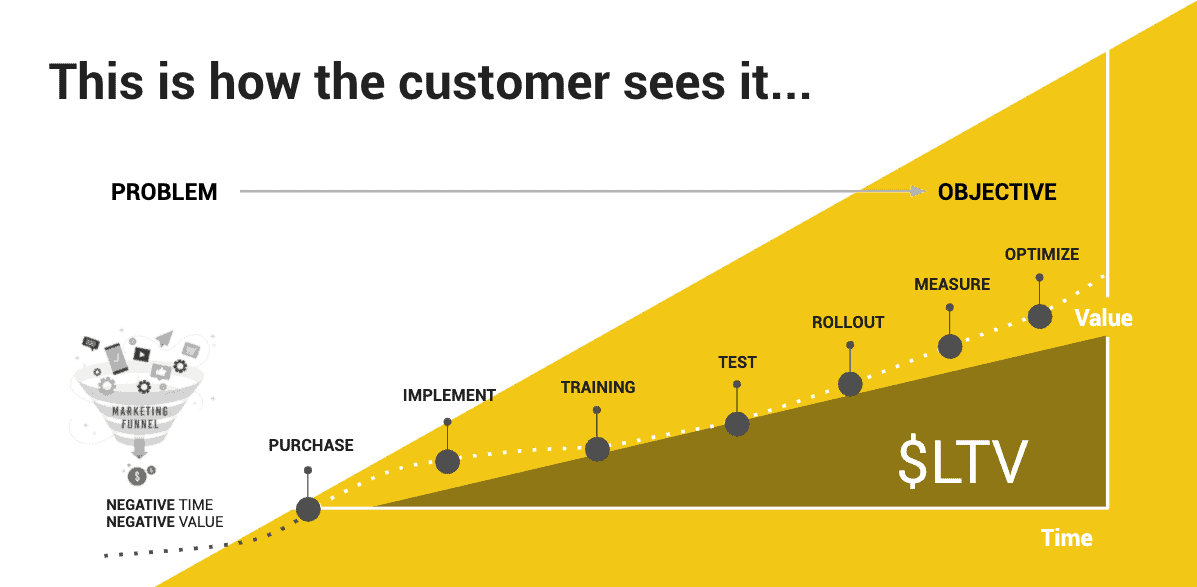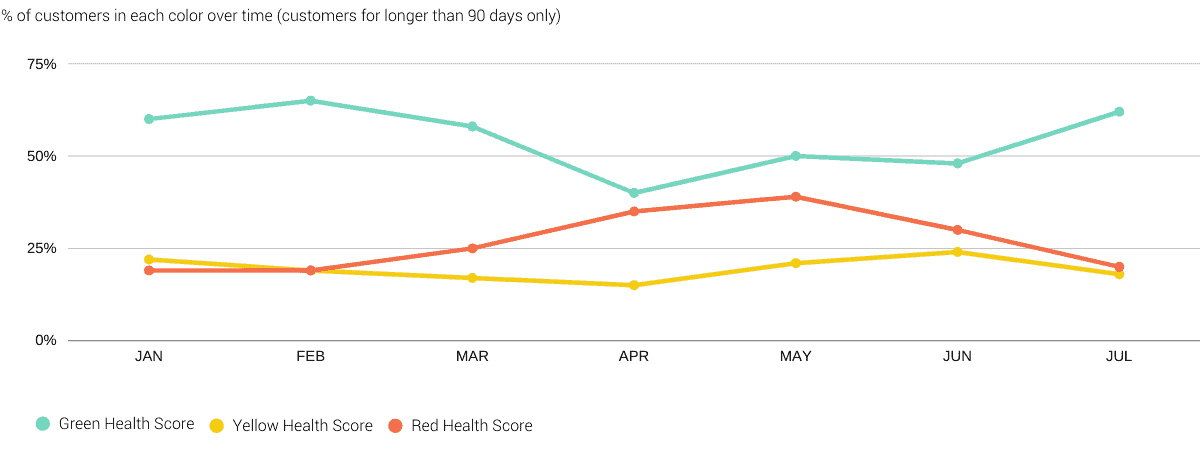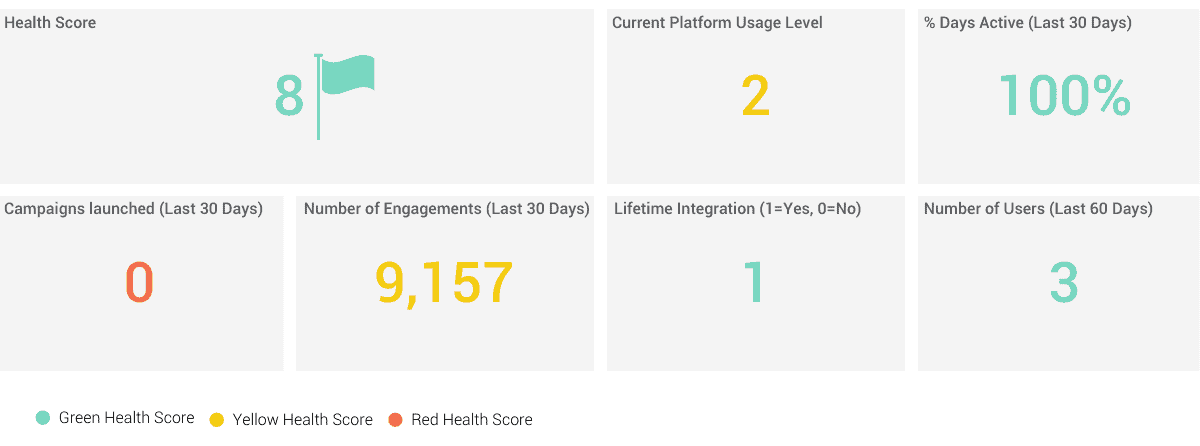To outline a hands-on, effective approach to customer health scoring, we sourced insights from the Customer Success Core. In this framework, you’ll learn how to design a scoring system that aligns to your growth strategy, brainstorm and select leader indicators of success, and operationalize the system across your startup.
After Jebbit raised its Series B, Michael Marcus, VP of Customer Success (CS), sat down with his team to plan their scale-up operations. He came across a surprising realization: the company was unintentionally “masking” groups of unhealthy customers, going above and beyond to provide great service to keep misaligned customers happy.
“Our renewal rate looked great, but as we began to dig into data, we realized it was because of our CS team and their high levels of service—it wasn’t necessarily a reflection of our software, our product/go-to-market fit, or the pain we were solving in the market,” he says.
“We weren’t learning from our customers and understanding our best- vs. worst-fit niche,” Marcus adds. This made it hard to chart a clear course: Jebbit’s message to the market was a bit too broad, causing Sales to bring in customers across a range of personas, prompting CS to invest extra resources to keep a wide variety of customers engaged.”
It’s not uncommon for early-stage teams to lean on CS to improve renewal rates and buy time for their software to catch up. But in Jebbit’s case, “we relied on this support for too long,” says Marcus. “We just didn’t have an unemotional source of truth to give us insight into our customers.” And so, the Jebbit team set out to build a customer health scoring system.
The Business Case for Customer Health Scoring
At its simplest level, customer health scoring provides you with a systematic, objective view into your customer’s relationship to your business. Your entire business relies on your customer’s success, making this insight incredibly important.
“It’s the marriage of quantitative and qualitative data,” says Marcus. “The quant tells you the unemotional reality of what’s happening, but you come to the real conclusion by bringing in your understanding of your customer and their business.”
“Customer health scoring gives you a common language to speak qualitatively and quantitatively about what’s going on,” says Sonciary Honnoll, Co-founder of Quala, a platform for managing and measuring Customer Success. “It paints a complete picture, allowing you to retain and expand customers because you know what makes them happy.”
You can use customer health scoring in a few different ways:
1. Identify ideal customers and hone sales personas. Health scoring makes it easier to identify ideal customers, which arms with you with feedback to loop back to Product, Sales, and Marketing.
2. Accurately forecast revenue retention and expansion. As a customer base grows and CSM bandwidth decreases, it becomes more and more difficult to track accounts. A scoring system identifies which customers are healthy and happy with your product.
3. Drive new levers of growth. Health scoring can also be a powerful tool for identifying the right accounts to down-sell, up-sell, or cross-sell. Through this work, it can drive new revenue opportunities.
4. Strategically allocate CS resources. A health scoring system helps prioritize customer interactions, so your CS team can be more strategic with their time. “Otherwise, you’re just spraying and praying,” adds Marcus.
“Ultimately, health scoring is just another tool in the toolbox; it’s not a command center,” says SaaSWorks’ Head of Operations Michael Redbord, who previously built HubSpot’s first customer health scoring system back in 2012. “It depends what you do with it.”
When should you start customer health scoring?
Throughout a product’s lifecycle, you’ll need to understand how customers use the product and pair that information with their feedback. Customer health scoring is a way to kick off this process and automate the tracking of these behaviors.
“Consider starting this on day one because you’ll see insights that you would otherwise miss,” says Honnoll. “If you don’t track those insights, it’s a huge missed opportunity.”
Plus, it becomes more difficult to retroactively put a system in place, so building the foundation early is valuable. “When a team implements a system at a later stage, they buy some giant tech solution, hoping it will fix all their problems,” says Bryce Delgrande, Manager of Customer Success at Shoobx. “But then you’re relying on technology to answer questions that you need to be able to answer yourself.”
Just like your product—and your business—health scoring evolves. As your understanding of your customer develops, your health score inputs will change. That’s why it’s important to just start.
How to Score Customer Health
Especially in the early days, keeping your scoring system simple and lean will help you:
1. Get it done faster. You’ll get 80% of the health score accuracy by doing 20% of the work. To start, you can simply test out Excel. “In HubSpot’s case, we eventually hired a world-class data science team, but our scoring only improved by a few points,” notes Redbord.
2. Operationalize and drive adoption with your team. Many people—especially the sociable folks who gravitate toward CS—don’t want a machine telling them how to interact with people. “Rather than trying to explain a complicated algorithm, you can say, the tool knows that this customer had more than 50 clicks in this app, so if we can get them to reach 100, there’s a higher chance they’ll renew,” says Redbord.
The team involved is simple too. You’ll need someone familiar with your data—perhaps a CTO or someone responsible for business operations. And you’ll need someone familiar with your customer—perhaps a CS leader. This person should be able to look at different data points and instinctively know which ones matter.
1. Define Your Customer Health Scoring Goal
To use customer health scoring wisely, you must first understand why you’re doing it. “If you don’t have that purpose, it’s going to be hard to decide which leading indicators to track,” says Redbord. “You’ve got to know the goal.”
One way to think about this is: What’s the best lever for your growth?
- Did you just acquire another company? Perhaps you want to cross-sell into it.
- Did you change your pricing? Perhaps you want to explore up-selling.
- Do you have a retention issue? Maybe you need to weed out unhealthy customers and revise your messaging.
Once you have a clear goal in mind, you can start to design a customer health scoring system.
In Jebbit’s case, the company was shifting its focus to product-led growth, meaning the CS team could no longer maintain its high-touch levels of support and would need to get more proactive and strategic about customer interaction. Plus, they needed to more accurately forecast revenue retention and expansion. “We needed data and dashboards to help operationalize our behaviors and optimize the time we spent as a team,” says Marcus.
2. Brainstorm Leading Indicators
When you first start, think through all the available, logical data points that lead a customer to your goal, also known as leading indicators. “If X is happening now, I can predict that the customer will do Y in the future.”
Zoom out: Walk through the major stages of your customer’s journey. Can you identify milestones of them graduating to the next step? Can you use these milestones in your health score?
(For more on mapping out this journey, take a look at our framework on Building Your Startup for Customer Success.)

Watch out: It can be easy to fall into the trap of over-engineering your health score. “Trying to create a health score with dozens of attributes doesn’t make any sense,” says Redbord. “Keep it simple, take a guess, and refine it from there.”
Consider getting your team together and brainstorming on a whiteboard (or a virtual board like Miro, if remote). Jot down specific, meaty metrics that can be categorized into the following six buckets:
Behavior: How many features are they trying? How often are they logging in?
Effort: How well does the product work for your customer? How easy is it for them to get the results they’re looking for?
CPIs: How are they doing on their Customer Performance Indicators? Is their business growing as a result of using your product?
Sentiment: How happy are customers with your product? This could include NPS or CSAT.
Engagement: How do they interact with your brand? Do they reply to your check-in emails? Do they click through to content in marketing emails?
Gut Check: You might not have a CS team, but whether it’s Sales, Services, or Founders—someone is talking to customers. How connected are customers to your vision and mission? How confident are they in using your product? How well do you know their Decision-Making Unit? Is your champion leaving the company?
For more information on Gut Check metrics, learn how Quala scores and tracks this data, and try this simple template in Google Sheets.
“It’s easy to fall into a trap of over-indexing on Behaviors,” says Honnoll. “Make sure you’re thinking of your higher-level business goal. Which indicators will contribute to those goals?”
The Jebbit team had historically relied too heavily on lagging indicators, so they brainstormed the quantitative leading metrics for value—what measurable customer actions were most correlated to renewal? In other words, what actions were most indicative of a happy customer?
The Jebbit team took to a whiteboard for this exercise and brainstormed every potential customer attribute that they could analyze. The result? Over 100 potential indicators, including:
- Time to first login
- Percentage of users taking a specific action
- Number of log-ins per paid account
- Percentage of key features leveraged over the last 30 days
- User month-over-month retention
3. Narrow the Scope
Once you have a brainstormed list, whittle it down by asking:
1. Is this data substantive enough? Data needs to be thick enough that it’s relevant across your customer base. An indicator needs to apply to most of your customers, so it can be used in a generalized way.
2. Is this indicator predictive of the thing that you want it to do? Let’s say you’re working on retention, and you have eight usage metrics with substantive volume. Are they correlated to retention? “It seems obvious, but double-check that these metrics are truly predictive of what you’re trying to measure,” says Redbord.
3. Can you see patterns? Data visualization can be helpful here to apply an expert human touch on top of the numbers. Look for breakpoints and patterns in these usage curves. “You’ll start to notice things like, ‘Oh if somebody is past this point in onboarding, then they’re typically going to be healthy at the 90-day mark,’” says Redbord.
Watch out: Your customer is changing and evolving, so data from 12+ months back may be irrelevant. Beware of small sample sizes!
Jebbit’s data needed to be quantitative, easy to automate, and represent leading metrics or behaviors. “If our behaviors and metrics led to customer value, we’d establish the proactive team culture that our customers would benefit from the most,” says Marcus.
Jebbit’s CS team partnered with the company’s Data Science and Analysis Team to better understand the relationship each customer attribute might have on renewal. After running the analysis, they ended up with a list of the 20+ customer attributes most positively (or negatively) correlated with renewal.
4. Build the Scoring System
To select your few final attributes, apply your qualitative understanding of your customer and their business needs. “This is the art amidst the science,” says Marcus.
Watch out: Correlation does not equal causation, which is why quant data is the perfect sidekick to your intuitive understanding of customer health. One cannot exist without the other.
Whether you have the opportunity to work with a data science team, or if you’re building something simple in Excel, as you create your algorithm, remember to:
1. Clean your data. Dirty data in multiple silos can cause problems, so work with your team to clean your data. “Pre-qualifier: if your data isn’t clean, your health score isn’t going to be accurate or helpful,” says Marcus.
2. Make sure the data is accessible. “If you have data in multiple silos, from day one think about what you need—is it in a place where you can pull it into a dashboard?” says Marcus. If possible, connect them all to a central database.
3. Just start. Ultimately, your data doesn’t need to be perfect. “You need some user data that goes back far enough, but don’t let perfect be the enemy of the good,” says Redbord. “It’s better to have something that sort of works, than to delay and have nothing at all.”
After reviewing their 100 brainstormed attributes, the Jebbit team selected five to use in their health scoring system. “With only five attributes, we’d be able to quickly and easily identify the drivers of a health score change and act on that insight,” Marcus adds. These attributes fall into two categories:
- Platform Usage Levels: How extensive is the customer’s usage of key features? How often do users engage with the platform?
- Experience Activity: How frequently does a customer launch an experience? What impact does that experience drive?
The scoring system tags customers as green, yellow, or red, depending on their health. With this new algorithm, the Jebbit team can predict renewals at a 93% accuracy rate. “Knowing this has given our CSM team great confidence that they can develop ways of working that guide a customer to green levels,” says Marcus.
5. Operationalize Your Health Scoring
“The value of a health score is as much about how you operationalize it as it is how it’s built. You can have the most accurate health score in the world, but if you fail to use it, it won’t help customers see more success,” says Redbord.
Reflecting on your original goal (why you are doing this in the first place), ask yourself:
- Who needs to access this information? This could include CSMs, a CS department, or startup executives.
- How will you proactively communicate with them? Dashboards and data visualizations can help show customer health, but you’ll also need to explain the context of the scoring system and set expectations for how you’ll use it.
- How will you measure its impact? Set quarterly or monthly targets to track the impact of your health score in a way that connects back to your original goal.
This is where tech comes in. “At this stage, consider looking for a customer success platform to help,” says Honnoll. “It’ll streamline operations—even for back-end automation.”
Jebbit needed to easily access health scores across their entire customer base, so dashboards break down data by each CSM cohort of customers and are made available across the company. “We leverage our dashboards daily to guide our behavior, focus our efforts, and give us an overall temperature check on our customer base,” says Marcus.
Dashboards include:
Note: The images below reflect fictional data.
1. Trend lines for the percentage of customers in Red, Yellow, or Green. These can be sorted daily, weekly or monthly. CSMs can also update the graph for their customers only. This view gives the Jebbit team visibility into macro impacts on customer health and allows them to get ahead of risks.

2. Single customer view. This shows the current health factors for any specific customers and is valuable for QBR preparation and internal health checks.

3. Changes in health. This shows customers whose health score has increased or decreased over any time frame. This view is one of the most valuable, as it helps to proactively flag and address risks or opportunities.

4. A sortable, high-level snapshot. This chart shows all Customers, their health scores, the factors contributing to their health score, and their CS team contacts.

As you work through this system, your scoring system will continue to evolve and iterate. You can refresh data, look for new attributes to track, test different notifications for health score changes, and think of additional ways to integrate these customer insights across your company.
“As your company grows, as your customers grow, as you begin to understand your customers better… it’s constantly evolving and changing. You’ll set it and continue to tweak it,” says Honnoll.
Big Picture
While it can be difficult to get right, “ultimately, customer health scoring enables you to trap information, normalize data, find trends—and rinse and repeat that process,” says Honnoll.
But customer health and happiness can’t exist in a CS silo. This feedback loop must connect to all aspects of the business—engineering, product, marketing, and sales, which is why it all begins by building your startup for customer success.
Have you implemented a customer health scoring system? How did you loop feedback across your company? Let us know by leaving a comment below, or reach out at hello@underscore.vc.






